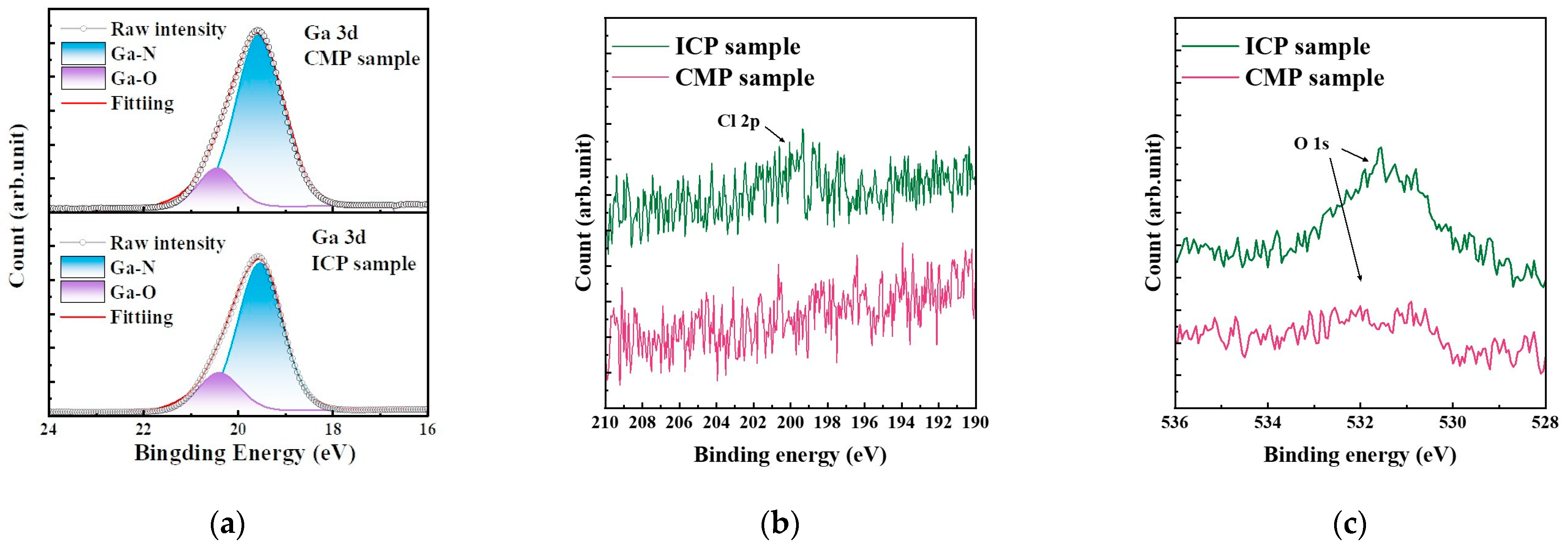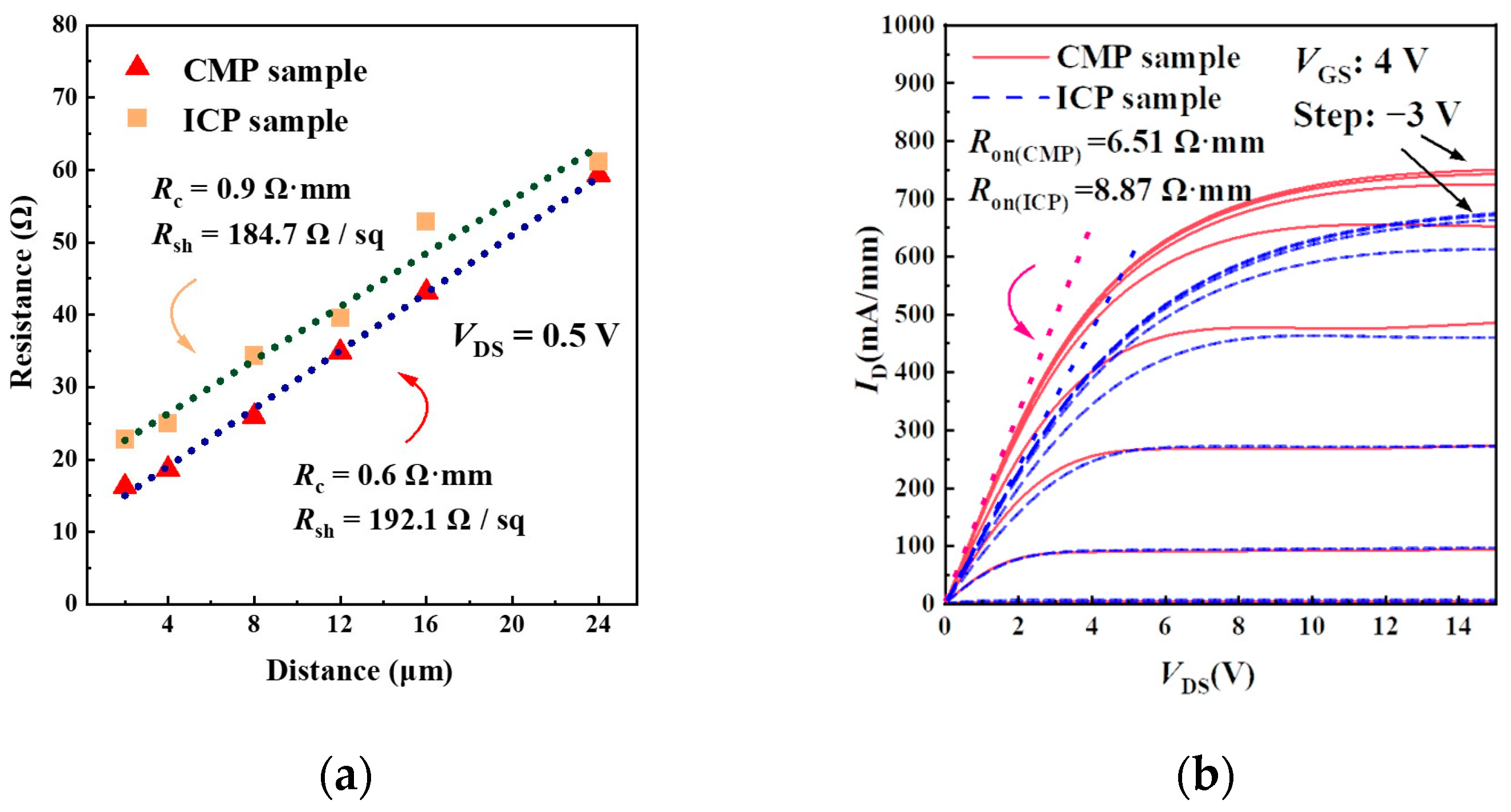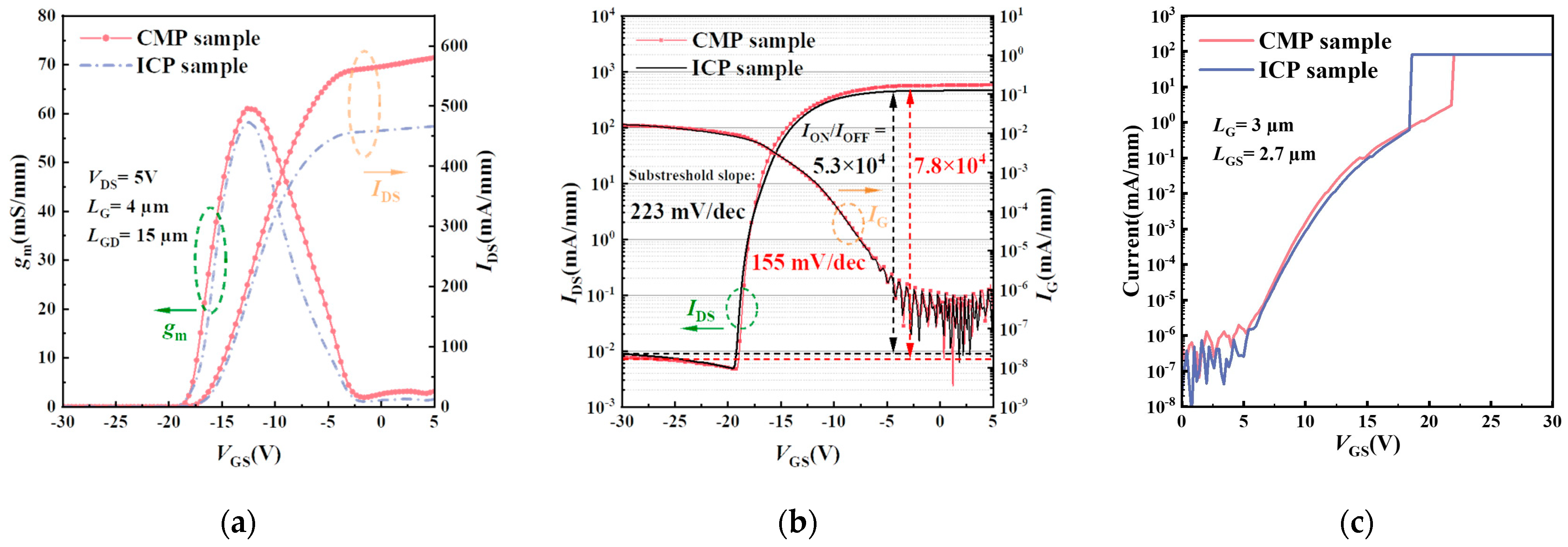High-Performance N-Polar GaN/AlGaN Metal–Insulator–Semiconductor High-Electron-Mobility Transistors with Low Surface Roughness Enabled by Chemical–Mechanical-Polishing-Incorporated Layer Transfer Technology
Abstract
1. Introduction
2. Experimental Methods
3. Results and Discussion
4. Conclusions
Author Contributions
Funding
Data Availability Statement
Conflicts of Interest
References
- Zhang, W.; Zhang, J.; Xiao, M.; Zhang, L.; Hao, Y. Al0.3Ga0.7N/GaN (10 nm)/Al0.1Ga0.9N HEMTs with low leakage current and high three-terminal breakdown voltage. IEEE Electron Device Lett. 2018, 39, 1370–1372. [Google Scholar] [CrossRef]
- Zhang, H.; Huang, C.; Song, K.; Yu, H.; Xing, C.; Wang, D.; Liu, Z.; Sun, H. Compositionally graded III-nitride alloys: Building blocks for efficient ultraviolet optoelectronics and power electronics. Rep. Prog. Phys. 2021, 84, 044401. [Google Scholar] [CrossRef]
- Du, H.; Liu, Z.; Hao, L.; Xing, W.; Zhou, H.; Zhao, S.; Zhang, J.; Hao, Y. High-Performance AlN/GaN MISHEMTs on Si With in-situ SiN Enhanced Ohmic Contacts for Mobile mm-Wave Front-End Applications. IEEE Electron Device Lett. 2023, 44, 911–914. [Google Scholar] [CrossRef]
- Masui, H.; Keller, S.; Fellows, N.; Fichtenbaum, N.A.; Furukawa, M.; Nakamura, S.; Mishra, U.K.; DenBaars, S.P. Luminescence characteristics of N-polar GaN and InGaN films grown by metal organic chemical vapor deposition. Jpn J. Appl. Phys. 2009, 48, 071003. [Google Scholar] [CrossRef]
- Li, W.; Romanczyk, B.; Akso, E.; Guidry, M.; Hatui, N.; Wurm, C.; Liu, W.; Shrestha, P.; Collins, H.; Clymore, C.; et al. Record 94 GHz performance from N-polar GaN-on-sapphire MIS-HEMTs: 5.8 W/mm and 38.5% PAE. In Proceedings of the 2022 International Electron Devices Meeting (IEDM), San Francisco, CA, USA, 3–7 December 2022; pp. 11–12. [Google Scholar]
- Wong, M.H.; Keller, S.; Nidhi, S.D.; Denninghoff, D.J.; Kolluri, S.; Brown, D.F.; Lu, J.; Fichtenbaum, N.A.; Ahmadi, E.; Singisetti, U.; et al. N-polar GaN epitaxy and high electron mobility transistors. Semicond. Sci. Technol. 2013, 28, 074009. [Google Scholar] [CrossRef]
- Wong, M.H.; Pei, Y.; Palacios, T.; Shen, L.; Chakraborty, A.; McCarthy, L.S.; Keller, S.; DenBaars, S.P.; Speck, J.S.; Mishra, U.K. Low nonalloyed Ohmic contact resistance to nitride high electron mobility transistors using N-face growth. Appl. Phys. Lett. 2007, 91, 232103. [Google Scholar] [CrossRef]
- Wang, Y.L.; Ren, F.; Zhang, U.; Sun, Q.; Yerino, C.D.; Ko, T.S.; Cho, Y.S.; Lee, I.H.; Han, J.; Pearton, S.J. Improved hydrogen detection sensitivity in N-polar GaN Schottky diodes. Appl. Phys. Lett. 2009, 94, 212108. [Google Scholar] [CrossRef]
- Keller, S.; Fichtenbaum, N.; Wu, F.; Lee, G.; DenBaars, S.P.; Speck, J.S.; Mishra, U.K. Effect of the nucleation conditions on the polarity of AlN and GaN films grown on C-face 6H–SiC. Jpn. J. Appl. Phys. 2006, 45, L322. [Google Scholar] [CrossRef]
- Sumiya, M.; Yoshimura, K.; Ito, T.; Ohtsuka, K.; Fuke, S.; Mizuno, K.; Yoshimoto, M.; Koinuma, H.; Ohtomo, A.; Kawasaki, M. Growth mode and surface morphology of a GaN film deposited along the N-face polar direction on c-plane sapphire substrate. J. Appl. Phys. 2000, 88, 1158–1165. [Google Scholar] [CrossRef]
- Storm, D.F.; Katzer, D.S.; Meyer, D.J.; Binari, S.C. Oxygen incorporation in homoepitaxial N-polar GaN grown by radio frequency-plasma assisted molecular beam epitaxy: Mitigation and modeling. J. Appl. Phys. 2012, 112, 013507. [Google Scholar] [CrossRef]
- Sumiya, M.; Yoshimura, K.; Ohtsuka, K.; Fuke, S. Dependence of impurity incorporation on the polar direction of GaN film growth. Appl. Phys. Lett. 2000, 76, 2098–2100. [Google Scholar] [CrossRef]
- Chung, J.W.; Piner, E.L.; Palacios, T. N-face GaN/AlGaN HEMTs fabricated through layer transfer technology. IEEE Electron Device Lett. 2008, 30, 113–116. [Google Scholar] [CrossRef]
- Ryu, K.K.; Roberts, J.C.; Piner, E.L.; Palacios, T. Thin-body N-face GaN transistor fabricated by direct wafer bonding. IEEE Electron Device Lett. 2011, 32, 895–897. [Google Scholar] [CrossRef]
- Yu, Z.; Zhang, L.; Yu, G.; Deng, X.; Jiang, C.; Tang, W.; Yin, H.; Liu, W.; Chen, Z.; Zhang, B. High quality of N-polar GaN film fabricated by layer transfer technology using high selective material removal rate of CMP. Mat. Sci. Semicon. Proc. 2022, 141, 106440. [Google Scholar] [CrossRef]
- Tautz, M.; Weimar, A.; Graßl, C.; Welzel, M.; Díaz Díaz, D. Anisotropy and Mechanistic Elucidation of Wet-Chemical Gallium Nitride Etching at the Atomic Level. Phys. Status Solidi A 2020, 217, 2000221. [Google Scholar] [CrossRef]
- Fang, C.Y.; Huang, W.J.; Chang, E.Y.; Lin, C.F.; Feng, M.S. Etching damages on AlGaN, GaN and InGaN caused by hybrid inductively coupled plasma etch and photoenhanced chemical wet etch by Schottky contact characterizations. Jpn. J. Appl. Phys. 2003, 42, 4207. [Google Scholar] [CrossRef]
- Ge, X.; Yin, X.; Zeng, Q.; Feng, Q.; Wang, X.; Li, Q.; Li, C. Study of dry etched N-polar (Al) GaN surfaces obtained by inductively coupled plasma etching. Front. Phys. 2022, 10, 1042998. [Google Scholar] [CrossRef]
- Cheung, R.; Rong, B.; van der Drift, E.W.J.M.; Sloof, W.G. Etch mechanism and etch-induced effects in the inductively coupled plasma etching of GaN. J. Vac. Sci. Technol. B 2003, 21, 1268–1272. [Google Scholar] [CrossRef]
- Zhang, H.; Sun, Y.; Hu, K.; Yang, L.; Liang, K.; Xing, Z.; Wang, H.; Zhang, M.; Yu, H.; Fang, S.; et al. Boosted high-temperature electrical characteristics of AlGaN/GaN HEMTs with rationally designed compositionally graded AlGaN back barriers. Sci. China Inf. Sci. 2023, 66, 182405. [Google Scholar] [CrossRef]
- Liu, S.; Zhang, J.; Zhao, S.; Shu, L.; Song, X.; Wang, C.; Li, T.; Liu, Z.; Hao, Y. Characterization of trap states in AlN/GaN superlattice channel high electron mobility transistors under total-ionizing-dose with 60Co γ-irradiation. Appl. Phys. Lett. 2022, 120, 202102. [Google Scholar] [CrossRef]
- Mizue, C.; Hori, Y.; Miczek, M.; Hashizume, T. Capacitance–voltage characteristics of Al2O3/AlGaN/GaN structures and state density distribution at Al2O3/AlGaN interface. Jpn. J. Appl. Phys. 2011, 50, 021001. [Google Scholar] [CrossRef]
- Zhang, Z.; Fu, K.; Deng, X.; Zhang, X.; Fan, Y.; Sun, S.; Song, L.; Xing, Z.; Huang, W.; Yu, G.; et al. Normally off AlGaN/GaN MIS-high-electron mobility transistors fabricated by using low pressure chemical vapor deposition Si3N4 gate dielectric and standard fluorine ion implantation. IEEE Electron Device Lett. 2015, 36, 1128–1131. [Google Scholar] [CrossRef]








| Sample | Surface Elemental Composition (at. %) | ||||
|---|---|---|---|---|---|
| Ga | N | O | C | Cl | |
| ICP | 36.46 | 42.92 | 4.51 | 15.6 | 0.51 |
| CMP | 39.72 | 50.92 | 1.27 | 8.09 | - |
Disclaimer/Publisher’s Note: The statements, opinions and data contained in all publications are solely those of the individual author(s) and contributor(s) and not of MDPI and/or the editor(s). MDPI and/or the editor(s) disclaim responsibility for any injury to people or property resulting from any ideas, methods, instructions or products referred to in the content. |
© 2024 by the authors. Licensee MDPI, Basel, Switzerland. This article is an open access article distributed under the terms and conditions of the Creative Commons Attribution (CC BY) license (https://creativecommons.org/licenses/by/4.0/).
Share and Cite
Guo, B.; Yu, G.; Zhang, L.; Zhou, J.; Wang, Z.; Xing, R.; Yang, A.; Li, Y.; Liu, B.; Zeng, X.; et al. High-Performance N-Polar GaN/AlGaN Metal–Insulator–Semiconductor High-Electron-Mobility Transistors with Low Surface Roughness Enabled by Chemical–Mechanical-Polishing-Incorporated Layer Transfer Technology. Crystals 2024, 14, 253. https://doi.org/10.3390/cryst14030253
Guo B, Yu G, Zhang L, Zhou J, Wang Z, Xing R, Yang A, Li Y, Liu B, Zeng X, et al. High-Performance N-Polar GaN/AlGaN Metal–Insulator–Semiconductor High-Electron-Mobility Transistors with Low Surface Roughness Enabled by Chemical–Mechanical-Polishing-Incorporated Layer Transfer Technology. Crystals. 2024; 14(3):253. https://doi.org/10.3390/cryst14030253
Chicago/Turabian StyleGuo, Bohan, Guohao Yu, Li Zhang, Jiaan Zhou, Zheming Wang, Runxian Xing, An Yang, Yu Li, Bosen Liu, Xiaohong Zeng, and et al. 2024. "High-Performance N-Polar GaN/AlGaN Metal–Insulator–Semiconductor High-Electron-Mobility Transistors with Low Surface Roughness Enabled by Chemical–Mechanical-Polishing-Incorporated Layer Transfer Technology" Crystals 14, no. 3: 253. https://doi.org/10.3390/cryst14030253
APA StyleGuo, B., Yu, G., Zhang, L., Zhou, J., Wang, Z., Xing, R., Yang, A., Li, Y., Liu, B., Zeng, X., Du, Z., Deng, X., Zeng, Z., & Zhang, B. (2024). High-Performance N-Polar GaN/AlGaN Metal–Insulator–Semiconductor High-Electron-Mobility Transistors with Low Surface Roughness Enabled by Chemical–Mechanical-Polishing-Incorporated Layer Transfer Technology. Crystals, 14(3), 253. https://doi.org/10.3390/cryst14030253






